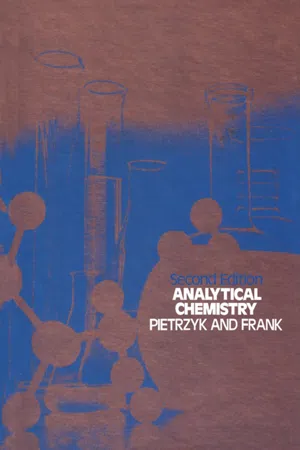
Analytical Chemistry
Clyde Frank
- 720 pagine
- English
- ePUB (disponibile sull'app)
- Disponibile su iOS e Android
Analytical Chemistry
Clyde Frank
Informazioni sul libro
Analytical Chemistry, Second Edition covers the fundamental principles of analytical chemistry. This edition is organized into 30 chapters that present various analytical chemistry methods. This book begins with a core of six chapters discussing the concepts basic to all of analytical chemistry. The fundamentals, concepts, applications, calculations, instrumentation, and chemical reactions of five major areas of analytical chemistry, namely, neutralization, potentiometry, spectroscopy, chromatography, and electrolysis methods, are emphasized in separate chapters. Other chapters are devoted to a discussion of precipitation and complexes in analytical chemistry. Principles and applications and the relationship of these reactions to the other areas are stressed. The remaining chapters of this edition are devoted to the laboratory. A chapter discusses the basic laboratory operations, with an emphasis on safety. This topic is followed by a series of experiments designed to reinforce the concepts developed in the chapters. This book is designed for introductory courses in analytical chemistry, especially those shorter courses servicing chemistry majors and life and health science majors.
Domande frequenti
Informazioni
Introduction to Analytical Chemistry
Publisher Summary
TO THE STUDENT
ANALYTICAL CHEMISTRY

Indice dei contenuti
- Cover image
- Title page
- Table of Contents
- Copyright
- Dedication
- Preface
- Chapter 1: Introduction to Analytical Chemistry
- Chapter 2: Development of an Analytical Method
- Chapter 3: Stoichiometry
- Chapter 4: Statistical Treatment of Analytical Data
- Chapter 5: Preliminary Operations in Quantitative Analysis
- Chapter 6: Introduction to Chemical Reactions in Analytical Chemistry
- Chapter 7: Precipitation Methods
- Chapter 8: Neutralization in Analytical Chemistry
- Chapter 9: Nonaqueous Acid–Base Titrations
- Chapter 10: Oxidation–Reduction Equilibria
- Chapter 11: Oxidation–Reduction Titrations
- Chapter 12: Oxidizing and Reducing Agents as Titrants in Analytical Chemistry
- Chapter 13: Ion-Selective Electrodes
- Chapter 14: Precipitation Titrations
- Chapter 15: Complexes in Analytical Chemistry: Complexometric Titrations
- Chapter 16: Introduction to Multiple Equilibrium Systems
- Chapter 17: Fundamental Principles of Optical Spectroscopy
- Chapter 18: Qualitative Analysis: Ultraviolet, Visible, and Infrared
- Chapter 19: Quantitative Analysis in Absorption Spectroscopy
- Chapter 20: Spectroscopy of Atoms
- Chapter 21: Luminescence
- Chapter 22: Separations: Introduction to Chromatography
- Chapter 23: Column Methods
- Chapter 24: Gas Chromatography
- Chapter 25: Sheet Methods
- Chapter 26: Ion Exchange
- Chapter 27: Solvent Extraction
- Chapter 28: Introduction to Electrochemistry
- Chapter 29: Polarography
- Chapter 30: Experimental Techniques
- Experiments
- Appendix I: MATHEMATICAL OPERATIONS
- Appendix II: SOLUBILITY PRODUCT CONSTANTS
- Appendix III: IONIZATION CONSTANTS OF WEAK ACIDS AND BASES
- Appendix IV: REDUCTION POTENTIALS
- Appendix V: LOG FORMATION CONSTANTS FOR METAL COMPLEXES
- Appendix VI: DISTRIBUTION DIAGRAMS FOR SELECTED COMPOUNDS
- Appendix VII: FOUR-PLACE LOGARITHMS
- PROBLEM ANSWERS
- Index